by Università di Bologna
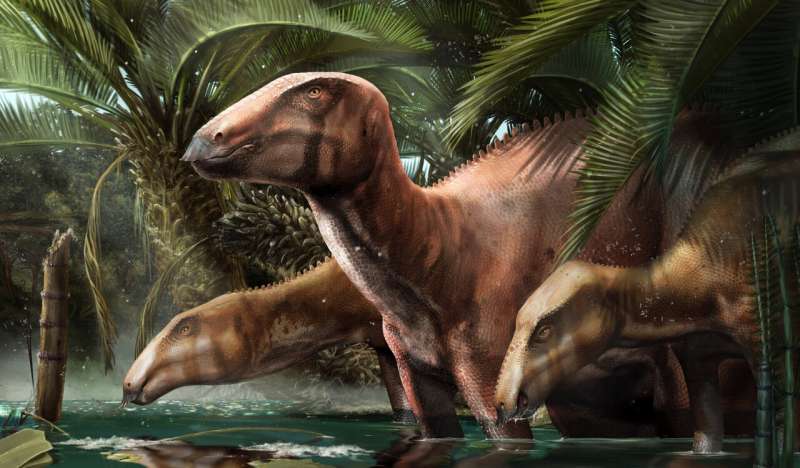
An adult and two juvenile individuals of the dinosaur Tethyshadros insularis showing the different appearances exhibited by immature and mature specimens in the ancient environment of Villaggio del Pescatore, the first locality in Italy preserving many dinosaur individuals of the same species. Credit: Davide Bonadonna
Italy is not exactly renowned for dinosaurs. In comparison to its excellent artistic and archaeological heritage, dinosaur fossils are very rare. Not surprisingly, the discovery of the first isolated dinosaurs in the early 1990s generated excitement, but are now considered nothing more than an exception to a general rule. During the reign of dinosaurs, between 230 and 66 million years ago, the ancient Mediterranean area would have been hard to map, formed by countless small islands far from all major mainlands—Europe, Africa, and Asia—unsuitable to sustain large animals like the dinosaurs. Or so we believed.
Now, a new study published in Scientific Reports and coordinated by researchers from the University of Bologna unveils the first palaeontological site with multiple, exceptionally complete dinosaur skeletons from Italy: the Villaggio del Pescatore site, located in the Duino-Aurisina municipality, near Trieste, in north-eastern Italy.
These beautiful skeletons belong to the species Tethyshadros insularis and represent the biggest and most complete dinosaur ever found in this country. The team describes the skeletons of some of the most beautiful and pristine dinosaurs from the site (in particular of a new individual nicknamed "Bruno") and highlights the occurrence of seven (probably 11) individuals at the Villaggio del Pescatore.
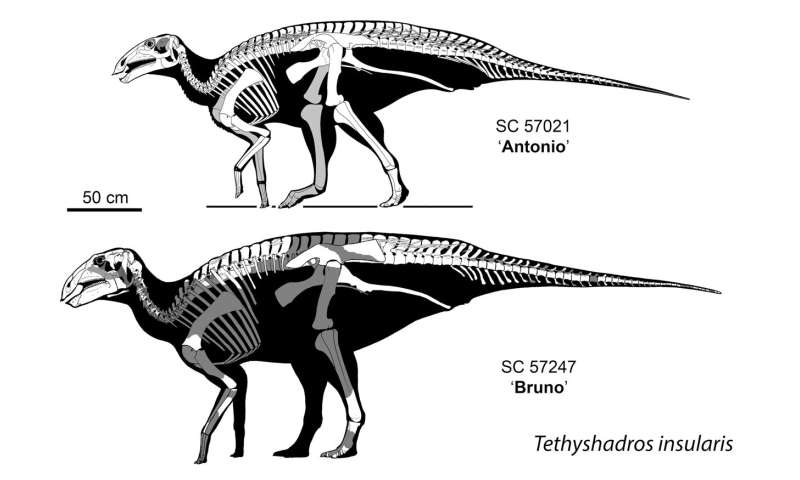
Italy is not exactly renowned for dinosaurs. In comparison to its excellent artistic and archaeological heritage, dinosaur fossils are very rare. Not surprisingly, the discovery of the first isolated dinosaurs in the early 1990s generated excitement, but are now considered nothing more than an exception to a general rule. During the reign of dinosaurs, between 230 and 66 million years ago, the ancient Mediterranean area would have been hard to map, formed by countless small islands far from all major mainlands—Europe, Africa, and Asia—unsuitable to sustain large animals like the dinosaurs. Or so we believed.
Now, a new study published in Scientific Reports and coordinated by researchers from the University of Bologna unveils the first palaeontological site with multiple, exceptionally complete dinosaur skeletons from Italy: the Villaggio del Pescatore site, located in the Duino-Aurisina municipality, near Trieste, in north-eastern Italy.
These beautiful skeletons belong to the species Tethyshadros insularis and represent the biggest and most complete dinosaur ever found in this country. The team describes the skeletons of some of the most beautiful and pristine dinosaurs from the site (in particular of a new individual nicknamed "Bruno") and highlights the occurrence of seven (probably 11) individuals at the Villaggio del Pescatore.

Skeletal reconstructions of the two individuals of Tethyshadros insularis, with the immature specimen nicknamed "Antonio" (above) and the mature, newly described skeleton of "Bruno" below. Credit: University of Bologna
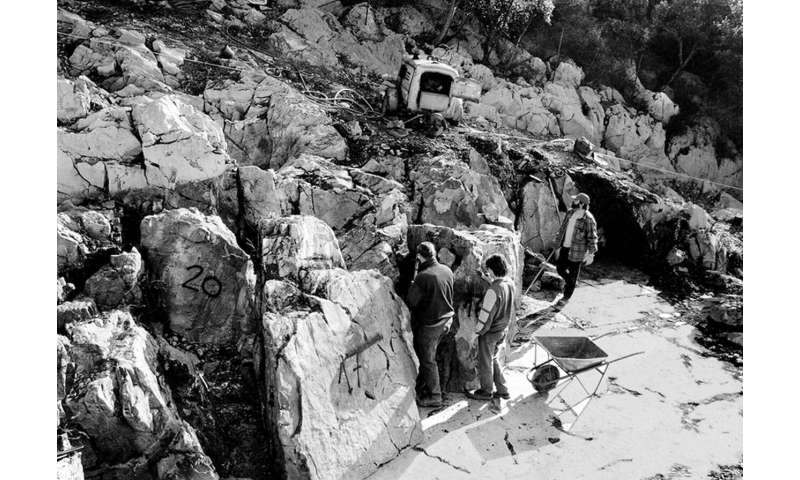

The palaeontological site of Villaggio del Pescatore, with people from ZOIC working to extract the fossils from this astounding dinosaur trove. Credit: ZOIC s.r.l.
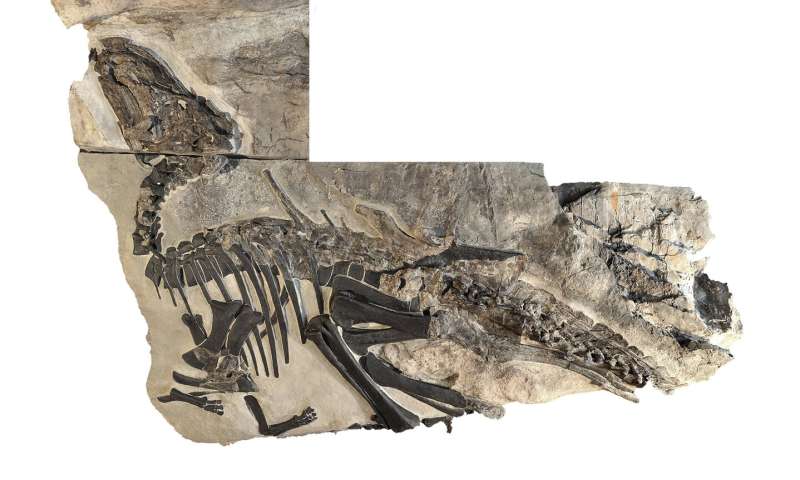

The skeleton of Bruno, an adult individual of the dinosaur Tethyshadros insularis described in this new study. Credit: P. Ferrieri (courtesy of Soprintendenza Archeologia, belle arti e paesaggio del Friuli-Venezia Giulia)
The study also reviews and rewrites many evolutionary hypotheses to interpret the ancient Mediterranean context. Originally, geologists interpreted the area that today is the Villaggio del Pescatore site as part of an island in the middle of a proto-Mediterranean ocean called Tethys. This supported the incorrect interpretation that the relatively small, first dinosaur skeleton found at the site (nicknamed Antonio), was actually a dwarf species, an example of the so-called island rule (the evolutionary miniaturization of bigger animals in an insular environment due to the scarcity of resources).
In this new study, the research team documents that Antonio is an immature individual, whereas Bruno, which is bigger in size, represents an older individual—and that could have been still growing at the time of its death.
New geological data gathered by the team also provided the age of the site and its fossils: approximately 80 million years ago, in the Cretaceous period. This is about 10 million years older than previously thought; quite a long time, even when dealing with dinosaurs. At that time, what is now north-eastern Italy was a land facing a vast ocean but connected to western Europe and Asia. This means that in addition to the small islands that characterized the ancient Mediterranean, many migratory routes for large terrestrial animals like the dinosaurs might have been possible across land bridges of what we nowadays call Italy.

The study also reviews and rewrites many evolutionary hypotheses to interpret the ancient Mediterranean context. Originally, geologists interpreted the area that today is the Villaggio del Pescatore site as part of an island in the middle of a proto-Mediterranean ocean called Tethys. This supported the incorrect interpretation that the relatively small, first dinosaur skeleton found at the site (nicknamed Antonio), was actually a dwarf species, an example of the so-called island rule (the evolutionary miniaturization of bigger animals in an insular environment due to the scarcity of resources).
In this new study, the research team documents that Antonio is an immature individual, whereas Bruno, which is bigger in size, represents an older individual—and that could have been still growing at the time of its death.
New geological data gathered by the team also provided the age of the site and its fossils: approximately 80 million years ago, in the Cretaceous period. This is about 10 million years older than previously thought; quite a long time, even when dealing with dinosaurs. At that time, what is now north-eastern Italy was a land facing a vast ocean but connected to western Europe and Asia. This means that in addition to the small islands that characterized the ancient Mediterranean, many migratory routes for large terrestrial animals like the dinosaurs might have been possible across land bridges of what we nowadays call Italy.

The skull of "Bruno", the newly described skeleton of the dinosaur Tethyshadros insularis. Credit: A. Giamborino (courtesy of Soprintendenza Archeologia, belle arti e paesaggio del Friuli-Venezia Giulia)
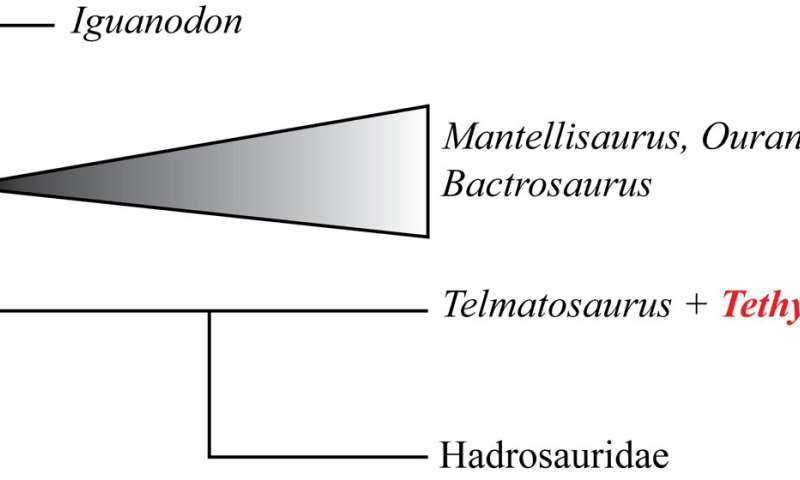

A simplified evolutionary tree showing where Tethyshadros would fit between its hadrosauriform relatives, the so-called duck-bill dinosaurs. Credit: University of Bologna
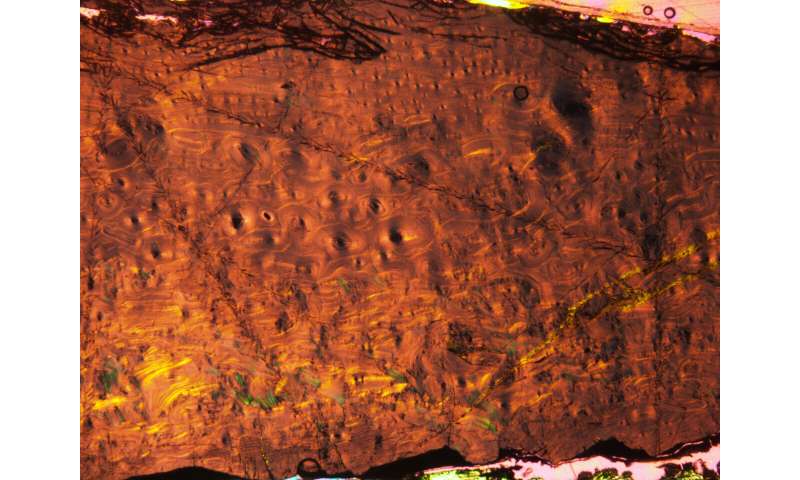

The bones of "Antonio" under the microscope, showing the bone cells (black, circled dots): the fossilised bone tissues were analysed to infer the relative age of the dinosaur skeletons at the time of their death. Credit: University of Bologna
This new research highlights the pivotal role of the Italian dinosaur fossil record for evaluating important scientific hypotheses on these ancient animals. As the site is already protected, new research activities may represent an opportunity to include the geological and paleontological heritage in the "must-see" list while visiting the Belpaese.
Explore furtherDuck-billed dinosaur may be one of many at Missouri site
More information: Alfio Alessandro Chiarenza et al, An Italian dinosaur Lagerstätte reveals the tempo and mode of hadrosauriform body size evolution, Scientific Reports (2021). DOI: 10.1038/s41598-021-02490-x
Journal information: Scientific Reports
Provided by Università di Bologna
This new research highlights the pivotal role of the Italian dinosaur fossil record for evaluating important scientific hypotheses on these ancient animals. As the site is already protected, new research activities may represent an opportunity to include the geological and paleontological heritage in the "must-see" list while visiting the Belpaese.
Explore furtherDuck-billed dinosaur may be one of many at Missouri site
More information: Alfio Alessandro Chiarenza et al, An Italian dinosaur Lagerstätte reveals the tempo and mode of hadrosauriform body size evolution, Scientific Reports (2021). DOI: 10.1038/s41598-021-02490-x
Journal information: Scientific Reports
Provided by Università di Bologna

No comments:
Post a Comment